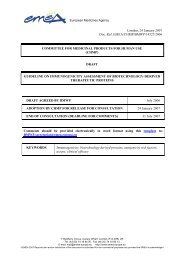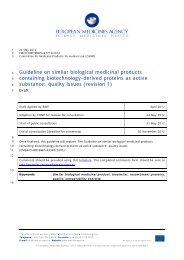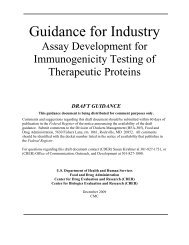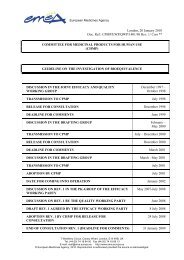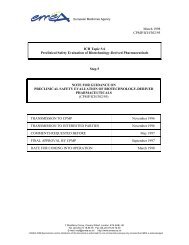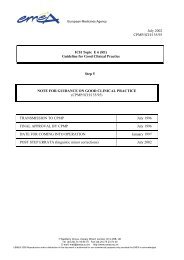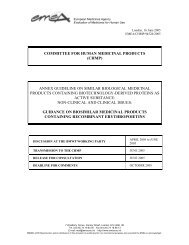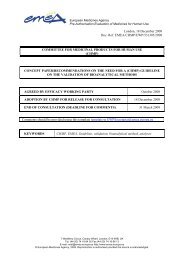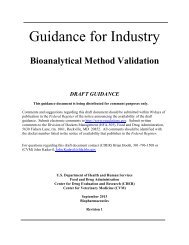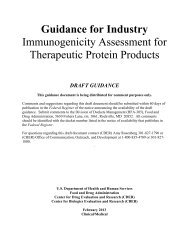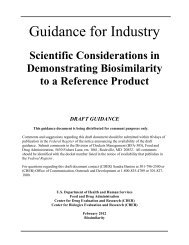Guidance for Industry - Bioanalytical Method Validation
Bioanalytical Method Validation, FDA, 2001 http://www.ipm-biotech.de/fileadmin/user_upload/pdf/guidelines/FDA-PK-Bioanalytical-method-validation-May2001.pdf
Bioanalytical Method Validation, FDA, 2001
http://www.ipm-biotech.de/fileadmin/user_upload/pdf/guidelines/FDA-PK-Bioanalytical-method-validation-May2001.pdf
Create successful ePaper yourself
Turn your PDF publications into a flip-book with our unique Google optimized e-Paper software.
<strong>Guidance</strong> <strong>for</strong> <strong>Industry</strong><br />
<strong>Bioanalytical</strong> <strong>Method</strong> <strong>Validation</strong><br />
U.S. Department of Health and Human Services<br />
Food and Drug Administration<br />
Center <strong>for</strong> Drug Evaluation and Research (CDER)<br />
Center <strong>for</strong> Veterinary Medicine (CVM)<br />
May 2001<br />
BP
<strong>Guidance</strong> <strong>for</strong> <strong>Industry</strong><br />
<strong>Bioanalytical</strong> <strong>Method</strong> <strong>Validation</strong><br />
Additional copies are available from:<br />
Drug In<strong>for</strong>mation Branch (HFD-210)<br />
Center <strong>for</strong> Drug Evaluation and Research (CDER)<br />
5600 Fishers Lane, Rockville, MD 20857 (Tel) 301-827-4573<br />
Internet at http://www.fda.gov/cder/guidance/index.htm<br />
or<br />
Communications Staff (HFV-12)<br />
Center <strong>for</strong> Veterinary Medicine (CVM)<br />
7500 Standish Place, Rockville, MD 20855 (Tel) 301–594-1755<br />
Internet at http://www.fda.gov/cvm<br />
U.S. Department of Health and Human Services<br />
Food and Drug Administration<br />
Center <strong>for</strong> Drug Evaluation and Research (CDER)<br />
Center <strong>for</strong> Veterinary Medicine (CVM)<br />
May 2001<br />
BP
Table of Contents<br />
I. INTRODUCTION..................................................................................................................................................................1<br />
II.<br />
III.<br />
IV.<br />
BACKGROUND....................................................................................................................................................................1<br />
A. FULL VALIDATION .............................................................................................................................................................. 2<br />
B. PARTIAL VALIDATION ........................................................................................................................................................ 2<br />
C. CROSS-VALIDATION ........................................................................................................................................................... 3<br />
REFERENCE STANDARD.............................................................................................................................................4<br />
METHOD DEVELOPMENT: CHEMICAL ASSAY........................................................................................................4<br />
A. SELECTIVITY....................................................................................................................................................................... 4<br />
B. ACCURACY, PRECISION, AND RECOVERY......................................................................................................................... 5<br />
C. CALIBRATION/STANDARD CURVE...................................................................................................................................... 5<br />
D. STABILITY........................................................................................................................................................................... 6<br />
E. PRINCIPLES OF BIOANALYTICAL METHOD VALIDATION AND ESTABLISHMENT ............................................................ 8<br />
F. SPECIFIC RECOMMENDATIONS FOR METHOD VALIDATION........................................................................................... 10<br />
V. METHOD DEVELOPMENT: MICROBIOLOGICAL AND LIGAND-BINDING ASSAYS ..................................11<br />
A. SELECTIVITY ISSUES ........................................................................................................................................................ 11<br />
B. QUANTIFICATION ISSUES ................................................................................................................................................. 12<br />
VI. APPLICATION OF VALIDATED METHOD TO ROUTINE DRUG ANALYSIS ....................................................13<br />
VII.<br />
ACCEPTANCE CRITERIA FOR THE RUN...................................................................................................................................... 15<br />
DOCUMENTATION......................................................................................................................................................16<br />
A. SUMMARY INFORMATION................................................................................................................................................. 16<br />
B. DOCUMENTATION FOR METHOD ESTABLISHMENT ....................................................................................................... 17<br />
C. APPLICATION TO ROUTINE DRUG ANALYSIS ................................................................................................................. 17<br />
D. OTHER INFORMATION...................................................................................................................................................... 19<br />
GLOSSARY....................................................................................................................................................................................20
GUIDANCE FOR INDUSTRY 1<br />
<strong>Bioanalytical</strong> <strong>Method</strong> <strong>Validation</strong><br />
This guidance represents the Food and Drug Administration's current thinking on this topic. It<br />
does not create or confer any rights <strong>for</strong> or on any person and does not operate to bind FDA or the<br />
public. An alternative approach may be used if such approach satisfies the requirements of the<br />
applicable statutes and regulations.<br />
I. INTRODUCTION<br />
This guidance provides assistance to sponsors of investigational new drug applications (INDs), new<br />
drug applications (NDAs), abbreviated new drug applications (ANDAs), and supplements in<br />
developing bioanalytical method validation in<strong>for</strong>mation used in human clinical pharmacology,<br />
bioavailability (BA), and bioequivalence (BE) studies requiring pharmacokinetic (PK) evaluation. This<br />
guidance also applies to bioanalytical methods used <strong>for</strong> non-human pharmacology/toxicology studies<br />
and preclinical studies. For studies related to the veterinary drug approval process, this guidance<br />
applies only to blood and urine BA, BE, and PK studies.<br />
The in<strong>for</strong>mation in this guidance generally applies to bioanalytical procedures such as gas<br />
chromatography (GC), high-pressure liquid chromatography (LC), combined GC and LC mass<br />
spectrometric (MS) procedures such as LC-MS, LC-MS-MS, GC-MS, and GC-MS-MS per<strong>for</strong>med<br />
<strong>for</strong> the quantitative determination of drugs and/or metabolites in biological matrices<br />
such as blood, serum, plasma, or urine. This guidance also applies to other bioanalytical methods, such<br />
as immunological and microbiological procedures, and to other biological matrices, such as tissue and<br />
skin samples.<br />
This guidance provides general recommendations <strong>for</strong> bioanalytical method validation. The<br />
recommendations can be adjusted or modified depending on the specific type of analytical method used.<br />
II.<br />
BACKGROUND<br />
1 This guidance has been prepared by the Biopharmaceutics Coordinating Committee in the Center <strong>for</strong> Drug Evaluation and<br />
Research (CDER) in cooperation with the Center <strong>for</strong> Veterinary Medicine (CVM) at the Food and Drug Administration.
This guidance has been developed based on the deliberations of two workshops: (1) Analytical<br />
<strong>Method</strong>s <strong>Validation</strong>: Bioavailability, Bioequivalence, and Pharmacokinetic Studies (held on December<br />
3B5, 1990 2 ) and (2) <strong>Bioanalytical</strong> <strong>Method</strong>s <strong>Validation</strong> C A Revisit With a Decade of Progress (held<br />
on January 12B14, 2000 3 ).<br />
Selective and sensitive analytical methods <strong>for</strong> the quantitative evaluation of drugs and their metabolites<br />
(analytes) are critical <strong>for</strong> the successful conduct of preclinical and/or biopharmaceutics and clinical<br />
pharmacology studies. <strong>Bioanalytical</strong> method validation includes all of the procedures that demonstrate<br />
that a particular method used <strong>for</strong> quantitative measurement of analytes in a given biological matrix, such<br />
as blood, plasma, serum, or urine, is reliable and reproducible <strong>for</strong> the intended use. The fundamental<br />
parameters <strong>for</strong> this validation include (1) accuracy, (2) precision, (3) selectivity, (4) sensitivity, (5)<br />
reproducibility, and (6) stability. <strong>Validation</strong> involves documenting, through the use of specific laboratory<br />
investigations, that the per<strong>for</strong>mance characteristics of the method are suitable and reliable <strong>for</strong> the<br />
intended analytical applications. The acceptability of analytical data corresponds directly to the criteria<br />
used to validate the method.<br />
Published methods of analysis are often modified to suit the requirements of the laboratory per<strong>for</strong>ming<br />
the assay. These modifications should be validated to ensure suitable per<strong>for</strong>mance of the analytical<br />
method. When changes are made to a previously validated method, the analyst should exercise<br />
judgment as to how much additional validation is needed. During the course of a typical drug<br />
development program, a defined bioanalytical method undergoes many modifications. The evolutionary<br />
changes to support specific studies and different levels of validation demonstrate the validity of an<br />
assay’s per<strong>for</strong>mance. Different types and levels of validation are defined and characterized as follows:<br />
A. Full <strong>Validation</strong><br />
• Full validation is important when developing and implementing a bioanalytical method <strong>for</strong><br />
the first time.<br />
• Full validation is important <strong>for</strong> a new drug entity.<br />
• A full validation of the revised assay is important if metabolites are added to an existing<br />
assay <strong>for</strong> quantification.<br />
B. Partial <strong>Validation</strong><br />
Partial validations are modifications of already validated bioanalytical methods. Partial validation<br />
can range from as little as one intra-assay accuracy and precision determination to a nearly full<br />
2 Workshop Report: Shah, V.P. et al., Pharmaceutical Research: 1992; 9:588-592.<br />
3 Workshop Report: Shah, V.P. et al., Pharmaceutical Research: 2000; 17:in press.<br />
2
validation. Typical bioanalytical method changes that fall into this category include, but are not<br />
limited to:<br />
• <strong>Bioanalytical</strong> method transfers between laboratories or analysts<br />
• Change in analytical methodology (e.g., change in detection systems)<br />
• Change in anticoagulant in harvesting biological fluid<br />
• Change in matrix within species (e.g., human plasma to human urine)<br />
• Change in sample processing procedures<br />
• Change in species within matrix (e.g., rat plasma to mouse plasma)<br />
• Change in relevant concentration range<br />
• Changes in instruments and/or software plat<strong>for</strong>ms<br />
• Limited sample volume (e.g., pediatric study)<br />
• Rare matrices<br />
• Selectivity demonstration of an analyte in the presence of concomitant medications<br />
• Selectivity demonstration of an analyte in the presence of specific metabolites<br />
C. Cross-<strong>Validation</strong><br />
Cross-validation is a comparison of validation parameters when two or more bioanalytical methods<br />
are used to generate data within the same study or across different studies. An example of crossvalidation<br />
would be a situation where an original validated bioanalytical method serves as the<br />
reference and the revised bioanalytical method is the comparator. The comparisons should be<br />
done both ways.<br />
When sample analyses within a single study are conducted at more than one site or more than one<br />
laboratory, cross-validation with spiked matrix standards and subject samples should be conducted<br />
at each site or laboratory to establish interlaboratory reliability. Cross-validation should also be<br />
considered when data generated using different analytical techniques (e.g., LC-MS-MS vs.<br />
ELISA 4 ) in different studies are included in a regulatory submission.<br />
All modifications should be assessed to determine the recommended degree of validation. The<br />
analytical laboratory conducting pharmacology/toxicology and other preclinical studies <strong>for</strong> regulatory<br />
submissions should adhere to FDA=s Good Laboratory Practices (GLPs) 5 (21 CFR part 58) and to<br />
sound principles of quality assurance throughout the testing process. The bioanalytical method <strong>for</strong><br />
human BA, BE, PK, and drug interaction studies must meet the criteria in 21 CFR 320.29. The<br />
analytical laboratory should have a written set of standard operating procedures (SOPs) to ensure a<br />
complete system of quality control and assurance. The SOPs should cover all aspects of analysis<br />
from the time the sample is collected and reaches the laboratory until the results of the analysis are<br />
reported. The SOPs also should include record keeping, security and chain of sample custody<br />
4 Enzyme linked immune sorbent assay<br />
5 For the Center <strong>for</strong> Veterinary Medicine, all bioequivalence studies are subject to Good Laboratory Practices.<br />
3
(accountability systems that ensure integrity of test articles), sample preparation, and analytical tools<br />
such as methods, reagents, equipment, instrumentation, and procedures <strong>for</strong> quality control and<br />
verification of results.<br />
The process by which a specific bioanalytical method is developed, validated, and used in routine<br />
sample analysis can be divided into (1) reference standard preparation, (2) bioanalytical method<br />
development and establishment of assay procedure, and (3) application of validated bioanalytical<br />
method to routine drug analysis and acceptance criteria <strong>for</strong> the analytical run and/or batch. These<br />
three processes are described in the following sections of this guidance.<br />
III.<br />
REFERENCE STANDARD<br />
Analysis of drugs and their metabolites in a biological matrix is carried out using samples spiked with<br />
calibration (reference) standards and using quality control (QC) samples. The purity of the reference<br />
standard used to prepare spiked samples can affect study data. For this reason, an authenticated<br />
analytical reference standard of known identity and purity should be used to prepare solutions of known<br />
concentrations. If possible, the reference standard should be identical to the analyte. When this is not<br />
possible, an established chemical <strong>for</strong>m (free base or acid, salt or ester) of known purity can be used.<br />
Three types of reference standards are usually used: (1) certified reference standards (e.g., USP<br />
compendial standards); (2) commercially supplied reference standards obtained from a reputable<br />
commercial source; and/or (3) other materials of documented purity custom-synthesized by an analytical<br />
laboratory or other noncommercial establishment. The source and lot number, expiration date,<br />
certificates of analyses when available, and/or internally or externally generated evidence of identity and<br />
purity should be furnished <strong>for</strong> each reference standard.<br />
IV.<br />
METHOD DEVELOPMENT: CHEMICAL ASSAY<br />
The method development and establishment phase defines the chemical assay. The fundamental<br />
parameters <strong>for</strong> a bioanalytical method validation are accuracy, precision, selectivity, sensitivity,<br />
reproducibility, and stability. Measurements <strong>for</strong> each analyte in the biological matrix should be<br />
validated. In addition, the stability of the analyte in spiked samples should be determined. Typical<br />
method development and establishment <strong>for</strong> a bioanalytical method include determination of (1)<br />
selectivity, (2) accuracy, precision, recovery, (3) calibration curve, and (4) stability of analyte in spiked<br />
samples.<br />
A. Selectivity<br />
Selectivity is the ability of an analytical method to differentiate and quantify the analyte in the<br />
presence of other components in the sample. For selectivity, analyses of blank samples of the<br />
appropriate biological matrix (plasma, urine, or other matrix) should be obtained from at least<br />
4
six sources. Each blank sample should be tested <strong>for</strong> interference, and selectivity should be<br />
ensured at the lower limit of quantification (LLOQ).<br />
Potential interfering substances in a biological matrix include endogenous matrix components,<br />
metabolites, decomposition products, and in the actual study, concomitant medication and other<br />
exogenous xenobiotics. If the method is intended to quantify more than one analyte, each<br />
analyte should be tested to ensure that there is no interference.<br />
B. Accuracy, Precision, and Recovery<br />
The accuracy of an analytical method describes the closeness of mean test results obtained by<br />
the method to the true value (concentration) of the analyte. Accuracy is determined by replicate<br />
analysis of samples containing known amounts of the analyte. Accuracy should be measured<br />
using a minimum of five determinations per concentration. A minimum of three concentrations in<br />
the range of expected concentrations is recommended. The mean value should be within 15%<br />
of the actual value except at LLOQ, where it should not deviate by more than 20%. The<br />
deviation of the mean from the true value serves as the measure of accuracy.<br />
The precision of an analytical method describes the closeness of individual measures of an<br />
analyte when the procedure is applied repeatedly to multiple aliquots of a single homogeneous<br />
volume of biological matrix. Precision should be measured using a minimum of five<br />
determinations per concentration. A minimum of three concentrations in the range of expected<br />
concentrations is recommended. The precision determined at each concentration level should<br />
not exceed 15% of the coefficient of variation (CV) except <strong>for</strong> the LLOQ, where it should not<br />
exceed 20% of the CV. Precision is further subdivided into within-run, intra-batch precision or<br />
repeatability, which assesses precision during a single analytical run, and between-run, interbatch<br />
precision or repeatability, which measures precision with time, and may involve different<br />
analysts, equipment, reagents, and laboratories.<br />
The recovery of an analyte in an assay is the detector response obtained from an amount of the<br />
analyte added to and extracted from the biological matrix, compared to the detector response<br />
obtained <strong>for</strong> the true concentration of the pure authentic standard. Recovery pertains to the<br />
extraction efficiency of an analytical method within the limits of variability. Recovery of the<br />
analyte need not be 100%, but the extent of recovery of an analyte and of the internal standard<br />
should be consistent, precise, and reproducible. Recovery experiments should be per<strong>for</strong>med by<br />
comparing the analytical results <strong>for</strong> extracted samples at three concentrations (low, medium, and<br />
high) with unextracted standards that represent 100% recovery.<br />
C. Calibration/Standard Curve<br />
A calibration (standard) curve is the relationship between instrument response and known<br />
concentrations of the analyte. A calibration curve should be generated <strong>for</strong> each analyte in the<br />
5
sample. A sufficient number of standards should be used to adequately define the relationship<br />
between concentration and response. A calibration curve should be prepared in the same<br />
biological matrix as the samples in the intended study by spiking the matrix with known<br />
concentrations of the analyte. The number of standards used in constructing a calibration curve<br />
will be a function of the anticipated range of analytical values and the nature of the<br />
analyte/response relationship. Concentrations of standards should be chosen on the basis of the<br />
concentration range expected in a particular study. A calibration curve should consist of a blank<br />
sample (matrix sample processed without internal standard), a zero sample (matrix sample<br />
processed with internal standard), and six to eight non-zero samples covering the expected<br />
range, including LLOQ.<br />
1. Lower Limit of Quantification (LLOQ)<br />
The lowest standard on the calibration curve should be accepted as the limit of<br />
quantification if the following conditions are met:<br />
C<br />
C<br />
The analyte response at the LLOQ should be at least 5 times the response<br />
compared to blank response.<br />
Analyte peak (response) should be identifiable, discrete, and reproducible with<br />
a precision of 20% and accuracy of 80-120%.<br />
2. Calibration Curve/Standard Curve/Concentration-Response<br />
The simplest model that adequately describes the concentration-response relationship<br />
should be used. Selection of weighting and use of a complex regression equation should<br />
be justified. The following conditions should be met in developing a calibration curve:<br />
C<br />
C<br />
#20% deviation of the LLOQ from nominal concentration<br />
#15% deviation of standards other than LLOQ from nominal concentration<br />
D. Stability<br />
At least four out of six non-zero standards should meet the above criteria, including the<br />
LLOQ and the calibration standard at the highest concentration. Excluding the<br />
standards should not change the model used.<br />
Drug stability in a biological fluid is a function of the storage conditions, the chemical properties<br />
of the drug, the matrix, and the container system. The stability of an analyte in a particular<br />
matrix and container system is relevant only to that matrix and container system and should not<br />
be extrapolated to other matrices and container systems. Stability procedures should evaluate<br />
the stability of the analytes during sample collection and handling, after long-term (frozen at the<br />
6
intended storage temperature) and short-term (bench top, room temperature) storage, and after<br />
going through freeze and thaw cycles and the analytical process. Conditions used in stability<br />
experiments should reflect situations likely to be encountered during actual sample handling and<br />
analysis. The procedure should also include an evaluation of analyte stability in stock solution.<br />
All stability determinations should use a set of samples prepared from a freshly made stock<br />
solution of the analyte in the appropriate analyte-free, interference-free biological matrix. Stock<br />
solutions of the analyte <strong>for</strong> stability evaluation should be prepared in an appropriate solvent at<br />
known concentrations.<br />
1. Freeze and Thaw Stability<br />
Analyte stability should be determined after three freeze and thaw cycles. At least three<br />
aliquots at each of the low and high concentrations should be stored at the intended<br />
storage temperature <strong>for</strong> 24 hours and thawed unassisted at room temperature. When<br />
completely thawed, the samples should be refrozen <strong>for</strong> 12 to 24 hours under the same<br />
conditions. The freeze–thaw cycle should be repeated two more times, then analyzed<br />
on the third cycle. If an analyte is unstable at the intended storage temperature, the<br />
stability sample should be frozen at -70 0 C during the three freeze and thaw cycles.<br />
2. Short-Term Temperature Stability<br />
Three aliquots of each of the low and high concentrations should be thawed at room<br />
temperature and kept at this temperature from 4 to 24 hours (based on the expected<br />
duration that samples will be maintained at room temperature in the intended study) and<br />
analyzed.<br />
3. Long-Term Stability<br />
The storage time in a long-term stability evaluation should exceed the time between the<br />
date of first sample collection and the date of last sample analysis. Long-term stability<br />
should be determined by storing at least three aliquots of each of the low and high<br />
concentrations under the same conditions as the study samples. The volume of samples<br />
should be sufficient <strong>for</strong> analysis on three separate occasions. The concentrations of all<br />
the stability samples should be compared to the mean of back-calculated values <strong>for</strong> the<br />
standards at the appropriate concentrations from the first day of long-term stability<br />
testing.<br />
4. Stock Solution Stability<br />
The stability of stock solutions of drug and the internal standard should be evaluated at<br />
room temperature <strong>for</strong> at least 6 hours. If the stock solutions are refrigerated or frozen<br />
7
<strong>for</strong> the relevant period, the stability should be documented. After completion of the<br />
desired storage time, the stability should be tested by comparing the instrument<br />
response with that of freshly prepared solutions.<br />
5. Post-Preparative Stability<br />
The stability of processed samples, including the resident time in the autosampler, should<br />
be determined. The stability of the drug and the internal standard should be assessed<br />
over the anticipated run time <strong>for</strong> the batch size in validation samples by determining<br />
concentrations on the basis of original calibration standards.<br />
Although the traditional approach of comparing analytical results <strong>for</strong> stored samples with<br />
those <strong>for</strong> freshly prepared samples has been referred to in this guidance, other statistical<br />
approaches based on confidence limits <strong>for</strong> evaluation of an analyte=s stability in a<br />
biological matrix can be used. SOPs should clearly describe the statistical method and<br />
rules used. Additional validation may include investigation of samples from dosed<br />
subjects.<br />
E. Principles of <strong>Bioanalytical</strong> <strong>Method</strong> <strong>Validation</strong> and Establishment<br />
• The fundamental parameters to ensure the acceptability of the per<strong>for</strong>mance of a<br />
bioanalytical method validation are accuracy, precision, selectivity, sensitivity,<br />
reproducibility, and stability.<br />
• A specific, detailed description of the bioanalytical method should be written. This can be in<br />
the <strong>for</strong>m of a protocol, study plan, report, and/or SOP.<br />
• Each step in the method should be investigated to determine the extent to which<br />
environmental, matrix, material, or procedural variables can affect the estimation of analyte<br />
in the matrix from the time of collection of the material up to and including the time of<br />
analysis.<br />
• It may be important to consider the variability of the matrix due to the physiological nature<br />
of the sample. In the case of LC-MS-MS-based procedures, appropriate steps should be<br />
taken to ensure the lack of matrix effects throughout the application of the method,<br />
especially if the nature of the matrix changes from the matrix used during method validation.<br />
• A bioanalytical method should be validated <strong>for</strong> the intended use or application. All<br />
experiments used to make claims or draw conclusions about the validity of the method<br />
should be presented in a report (method validation report).<br />
8
• Whenever possible, the same biological matrix as the matrix in the intended samples should<br />
be used <strong>for</strong> validation purposes. (For tissues of limited availability, such as bone marrow,<br />
physiologically appropriate proxy matrices can be substituted.)<br />
• The stability of the analyte (drug and/or metabolite) in the matrix during the collection<br />
process and the sample storage period should be assessed, preferably prior to sample<br />
analysis.<br />
• For compounds with potentially labile metabolites, the stability of analyte in matrix from<br />
dosed subjects (or species) should be confirmed.<br />
• The accuracy, precision, reproducibility, response function, and selectivity of the method <strong>for</strong><br />
endogenous substances, metabolites, and known degradation products should be<br />
established <strong>for</strong> the biological matrix. For selectivity, there should be evidence that the<br />
substance being quantified is the intended analyte.<br />
• The concentration range over which the analyte will be determined should be defined in the<br />
bioanalytical method, based on evaluation of actual standard samples over the range,<br />
including their statistical variation. This defines the standard curve.<br />
• A sufficient number of standards should be used to adequately define the relationship<br />
between concentration and response. The relationship between response and concentration<br />
should be demonstrated to be continuous and reproducible. The number of standards used<br />
should be a function of the dynamic range and nature of the concentration-response<br />
relationship. In many cases, six to eight concentrations (excluding blank values) can define<br />
the standard curve. More standard concentrations may be recommended <strong>for</strong> nonlinear than<br />
<strong>for</strong> linear relationships.<br />
• The ability to dilute samples originally above the upper limit of the standard curve should be<br />
demonstrated by accuracy and precision parameters in the validation.<br />
• In consideration of high throughput analyses, including but not limited to multiplexing,<br />
multicolumn, and parallel systems, sufficient QC samples should be used to ensure control<br />
of the assay. The number of QC samples to ensure proper control of the assay should be<br />
determined based on the run size. The placement of QC samples should be judiciously<br />
considered in the run.<br />
• For a bioanalytical method to be considered valid, specific acceptance criteria should be set<br />
in advance and achieved <strong>for</strong> accuracy and precision <strong>for</strong> the validation of QC samples over<br />
the range of the standards.<br />
9
F. Specific Recommendations <strong>for</strong> <strong>Method</strong> <strong>Validation</strong><br />
• The matrix-based standard curve should consist of a minimum of six standard points,<br />
excluding blanks, using single or replicate samples. The standard curve should cover the<br />
entire range of expected concentrations.<br />
• Standard curve fitting is determined by applying the simplest model that adequately<br />
describes the concentration-response relationship using appropriate weighting and statistical<br />
tests <strong>for</strong> goodness of fit.<br />
• LLOQ is the lowest concentration of the standard curve that can be measured with<br />
acceptable accuracy and precision. The LLOQ should be established using at least five<br />
samples independent of standards and determining the coefficient of variation and/or<br />
appropriate confidence interval. The LLOQ should serve as the lowest concentration on<br />
the standard curve and should not be confused with the limit of detection and/or the low QC<br />
sample. The highest standard will define the upper limit of quantification (ULOQ) of an<br />
analytical method.<br />
• For validation of the bioanalytical method, accuracy and precision should be determined<br />
using a minimum of five determinations per concentration level (excluding blank samples).<br />
The mean value should be within ±15% of the theoretical value, except at LLOQ, where it<br />
should not deviate by more than ±20%. The precision around the mean value should not<br />
exceed 15% of the CV, except <strong>for</strong> LLOQ, where it should not exceed 20% of the CV.<br />
Other methods of assessing accuracy and precision that meet these limits may be equally<br />
acceptable.<br />
• The accuracy and precision with which known concentrations of analyte in biological matrix<br />
can be determined should be demonstrated. This can be accomplished by analysis of<br />
replicate sets of analyte samples of known concentrations C QC samples C from an<br />
equivalent biological matrix. At a minimum, three concentrations representing the entire<br />
range of the standard curve should be studied: one within 3x the lower limit of quantification<br />
(LLOQ) (low QC sample), one near the center (middle QC), and one near the upper<br />
boundary of the standard curve (high QC).<br />
• Reported method validation data and the determination of accuracy and precision should<br />
include all outliers; however, calculations of accuracy and precision excluding values that are<br />
statistically determined as outliers can also be reported.<br />
• The stability of the analyte in biological matrix at intended storage temperatures should be<br />
established. The influence of freeze-thaw cycles (a minimum of three cycles at two<br />
concentrations in triplicate) should be studied.<br />
10
• The stability of the analyte in matrix at ambient temperature should be evaluated over a time<br />
period equal to the typical sample preparation, sample handling, and analytical run times.<br />
• Reinjection reproducibility should be evaluated to determine if an analytical run could be<br />
reanalyzed in the case of instrument failure.<br />
• The specificity of the assay methodology should be established using a minimum of six<br />
independent sources of the same matrix. For hyphenated mass spectrometry-based<br />
methods, however, testing six independent matrices <strong>for</strong> interference may not be important.<br />
In the case of LC-MS and LC-MS-MS-based procedures, matrix effects should be<br />
investigated to ensure that precision, selectivity, and sensitivity will not be compromised.<br />
<strong>Method</strong> selectivity should be evaluated during method development and throughout method<br />
validation and can continue throughout application of the method to actual study samples.<br />
• Acceptance/rejection criteria <strong>for</strong> spiked, matrix-based calibration standards and validation<br />
QC samples should be based on the nominal (theoretical) concentration of analytes.<br />
Specific criteria can be set up in advance and achieved <strong>for</strong> accuracy and precision over the<br />
range of the standards, if so desired.<br />
V. METHOD DEVELOPMENT: MICROBIOLOGICAL AND LIGAND-BINDING<br />
ASSAYS<br />
Many of the bioanalytical validation parameters and principles discussed above are also applicable to<br />
microbiological and ligand-binding assays. However, these assays possess some unique characteristics<br />
that should be considered during method validation.<br />
A. Selectivity Issues<br />
As with chromatographic methods, microbiological and ligand-binding assays should be shown<br />
to be selective <strong>for</strong> the analyte. The following recommendations <strong>for</strong> dealing with two selectivity<br />
issues should be considered:<br />
1. Interference From Substances Physiochemically Similar to the Analyte<br />
• Cross-reactivity of metabolites, concomitant medications, or endogenous<br />
compounds should be evaluated individually and in combination with the analyte<br />
of interest.<br />
• When possible, the immunoassay should be compared with a validated reference<br />
method (such as LC-MS) using incurred samples and predetermined criteria <strong>for</strong><br />
agreement of accuracy of immunoassay and reference method.<br />
11
• The dilutional linearity to the reference standard should be assessed using study<br />
(incurred) samples.<br />
• Selectivity may be improved <strong>for</strong> some analytes by incorporation of separation<br />
steps prior to immunoassay.<br />
2. Matrix effects Unrelated to the Analyte<br />
• The standard curve in biological fluids should be compared with standard in<br />
buffer to detect matrix effects.<br />
• Parallelism of diluted study samples should be evaluated with diluted standards to<br />
detect matrix effects.<br />
• Nonspecific binding should be determined.<br />
B. Quantification Issues<br />
Microbiological and imunoassay standard curves are inherently nonlinear and, in general, more<br />
concentration points may be recommended to define the fit over the standard curve range than<br />
<strong>for</strong> chemical assays. In addition to their nonlinear characteristics, the response-error<br />
relationship <strong>for</strong> immunoassay standard curves is a nonconstant function of the mean response<br />
(heteroscadisticity). For these reasons, a minimum of six non-zero calibrator concentrations,<br />
run in duplicate, is recommended. The concentration-response relationship is most often fitted<br />
to a 4- or 5-parameter logistic model, although others may be used with suitable validation. The<br />
use of anchoring points in the asymptotic high- and low-concentration ends of the standard<br />
curve may improve the overall curve fit. Generally, these anchoring points will be at<br />
concentrations that are below the established LLOQ and above the established ULOQ.<br />
Whenever possible, calibrators should be prepared in the same matrix as the study samples or<br />
in an alternate matrix of equivalent per<strong>for</strong>mance. Both ULOQ and LLOQ should be defined by<br />
acceptable accuracy, precision, or confidence interval criteria based on the study requirements.<br />
For all assays the key factor is the accuracy of the reported results. This accuracy can be<br />
improved by the use of replicate samples. In the case where replicate samples should be<br />
measured during the validation to improve accuracy, the same procedure should be followed as<br />
<strong>for</strong> unknown samples.<br />
The following recommendations apply to quantification issues:<br />
• If separation is used prior to assay <strong>for</strong> study samples but not <strong>for</strong> standards, it is important to<br />
establish recovery and use it in determining results. Possible approaches to assess efficiency<br />
12
and reproducibility of recovery are (1) the use of radiolabeled tracer analyte (quantity too<br />
small to affect the assay), (2) the advance establishment of reproducible recovery, (3) the<br />
use of an internal standard that is not recognized by the antibody but can be measured by<br />
another technique.<br />
• Key reagents, such as antibody, tracer, reference standard, and matrix should be<br />
characterized appropriately and stored under defined conditions.<br />
• Assessments of analyte stability should be conducted in true study matrix (e.g., should not<br />
use a matrix stripped to remove endogenous interferences).<br />
• Acceptance criteria: At least 67% (4 out of 6) of QC samples should be within 15% of<br />
their respective nominal value, 33% of the QC samples (not all replicates at the same<br />
concentration) may be outside 15% of nominal value. In certain situations, wider<br />
acceptance criteria may be justified.<br />
• Assay reoptimization or validation may be important when there are changes in key<br />
reagents, as follows:<br />
Labeled analyte (tracer)<br />
• Binding should be reoptimized.<br />
• Per<strong>for</strong>mance should be verified with standard curve and QCs.<br />
Antibody<br />
• Key cross-reactivities should be checked.<br />
• Tracer experiments above should be repeated.<br />
Matrix<br />
• Tracer experiments above should be repeated.<br />
<strong>Method</strong> development experiments should include a minimum of six runs conducted over several days,<br />
with at least four concentrations (LLOQ, low, medium, and high) analyzed in duplicate in each run.<br />
VI.<br />
APPLICATION OF VALIDATED METHOD TO ROUTINE DRUG ANALYSIS<br />
Assays of all samples of an analyte in a biological matrix should be completed within the time period <strong>for</strong><br />
which stability data are available. In general, biological samples can be analyzed with a single<br />
determination without duplicate or replicate analysis if the assay method has acceptable variability as<br />
defined by validation data. This is true <strong>for</strong> procedures where precision and accuracy variabilities<br />
routinely fall within acceptable tolerance limits. For a difficult procedure with a labile analyte where high<br />
precision and accuracy specifications may be difficult to achieve, duplicate or even triplicate analyses<br />
can be per<strong>for</strong>med <strong>for</strong> a better estimate of analyte.<br />
13
A calibration curve should be generated <strong>for</strong> each analyte to assay samples in each analytical run and<br />
should be used to calculate the concentration of the analyte in the unknown samples in the run. The<br />
spiked samples can contain more than one analyte. An analytical run can consist of QC samples,<br />
calibration standards, and either (1) all the processed samples to be analyzed as one batch or (2) a<br />
batch composed of processed unknown samples of one or more volunteers in a study. The calibration<br />
(standard) curve should cover the expected unknown sample concentration range in addition to a<br />
calibrator sample at LLOQ. Estimation of concentration in unknown samples by extrapolation of<br />
standard curves below LLOQ or above the highest standard is not recommended. Instead, the<br />
standard curve should be redefined or samples with higher concentration should be diluted and<br />
reassayed. It is preferable to analyze all study samples from a subject in a single run.<br />
Once the analytical method has been validated <strong>for</strong> routine use, its accuracy and precision should be<br />
monitored regularly to ensure that the method continues to per<strong>for</strong>m satisfactorily. To achieve this<br />
objective, a number of QC samples prepared separately should be analyzed with processed test<br />
samples at intervals based on the total number of samples. The QC samples in duplicate at three<br />
concentrations (one near the LLOQ (i.e., #3 x LLOQ), one in midrange, and one close to the high end<br />
of the range) should be incorporated in each assay run. The number of QC samples (in multiples of<br />
three) will depend on the total number of samples in the run. The results of the QC samples provide the<br />
basis of accepting or rejecting the run. At least four of every six QC samples should be within "15% of<br />
their respective nominal value. Two of the six QC samples may be outside the "15% of their respective<br />
nominal value, but not both at the same concentration.<br />
The following recommendations should be noted in applying a bioanalytical method to routine drug<br />
analysis:<br />
• A matrix-based standard curve should consist of a minimum of six standard points,<br />
excluding blanks (either single or replicate), covering the entire range.<br />
• Response Function: Typically, the same curve fitting, weighting, and goodness of fit<br />
determined during prestudy validation should be used <strong>for</strong> the standard curve within the<br />
study. Response function is determined by appropriate statistical tests based on the actual<br />
standard points during each run in the validation. Changes in the response function<br />
relationship between prestudy validation and routine run validation indicate potential<br />
problems.<br />
• The QC samples should be used to accept or reject the run. These QC samples are matrix<br />
spiked with analyte.<br />
• System suitability: Based on the analyte and technique, a specific SOP (or sample) should<br />
be identified to ensure optimum operation of the system used.<br />
14
• Any required sample dilutions should use like matrix (e.g., human to human) obviating the<br />
need to incorporate actual within-study dilution matrix QC samples.<br />
• Repeat Analysis: It is important to establish an SOP or guideline <strong>for</strong> repeat analysis and<br />
acceptance criteria. This SOP or guideline should explain the reasons <strong>for</strong> repeating sample<br />
analysis. Reasons <strong>for</strong> repeat analyses could include repeat analysis of clinical or preclinical<br />
samples <strong>for</strong> regulatory purposes, inconsistent replicate analysis, samples outside of the assay<br />
range, sample processing errors, equipment failure, poor chromatography, and inconsistent<br />
pharmacokinetic data. Reassays should be done in triplicate if sample volume allows. The<br />
rationale <strong>for</strong> the repeat analysis and the reporting of the repeat analysis should be clearly<br />
documented.<br />
• Sample Data Reintegration: An SOP or guideline <strong>for</strong> sample data reintegration should be<br />
established. This SOP or guideline should explain the reasons <strong>for</strong> reintegration and how the<br />
reintegration is to be per<strong>for</strong>med. The rationale <strong>for</strong> the reintegration should be clearly<br />
described and documented. Original and reintegration data should be reported.<br />
Acceptance Criteria <strong>for</strong> the Run<br />
The following acceptance criteria should be considered <strong>for</strong> accepting the analytical run:<br />
• Standards and QC samples can be prepared from the same spiking stock solution,<br />
provided the solution stability and accuracy have been verified. A single source of matrix<br />
may also be used, provided selectivity has been verified.<br />
• Standard curve samples, blanks, QCs, and study samples can be arranged as considered<br />
appropriate within the run.<br />
• Placement of standards and QC samples within a run should be designed to detect assay<br />
drift over the run.<br />
• Matrix-based standard calibration samples: 75%, or a minimum of six standards, when<br />
back-calculated (including ULOQ) should fall within ±15%, except <strong>for</strong> LLOQ, when it<br />
should be ±20% of the nominal value. Values falling outside these limits can be discarded,<br />
provided they do not change the established model.<br />
• Acceptance criteria <strong>for</strong> accuracy and precision as outlined in section IV.F, “Specific<br />
Recommendation <strong>for</strong> <strong>Method</strong> <strong>Validation</strong>,” should be provided <strong>for</strong> both the intra-day and<br />
intra-run experiment.<br />
• Quality Control Samples: Quality control samples replicated (at least once) at a minimum of<br />
three concentrations (one within 3x of the LLOQ (low QC), one in the midrange (middle<br />
15
QC), and one approaching the high end of the range (high QC)) should be incorporated into<br />
each run. The results of the QC samples provide the basis of accepting or rejecting the run.<br />
At least 67% (four out of six) of the QC samples should be within 15% of their respective<br />
nominal (theoretical) values; 33% of the QC samples (not all replicates at the same<br />
concentration) can be outside the ±15% of the nominal value. A confidence interval<br />
approach yielding comparable accuracy and precision is an appropriate alternative.<br />
The minimum number of samples (in multiples of three) should be at least 5% of the number of<br />
unknown samples or six total QCs, whichever is greater.<br />
• Samples involving multiple analytes should not be rejected based on the data from one<br />
analyte failing the acceptance criteria.<br />
• The data from rejected runs need not be documented, but the fact that a run was rejected<br />
and the reason <strong>for</strong> failure should be recorded.<br />
VII.<br />
DOCUMENTATION<br />
The validity of an analytical method should be established and verified by laboratory studies, and<br />
documentation of successful completion of such studies should be provided in the assay validation<br />
report. General and specific SOPs and good record keeping are an essential part of a validated<br />
analytical method. The data generated <strong>for</strong> bioanalytical method establishment and the QCs should be<br />
documented and available <strong>for</strong> data audit and inspection. Documentation <strong>for</strong> submission to the Agency<br />
should include (1) summary in<strong>for</strong>mation, (2) method development and establishment, (3) bioanalytical<br />
reports of the application of any methods to routine sample analysis, and (4) other in<strong>for</strong>mation<br />
applicable to method development and establishment and/or to routine sample analysis.<br />
A. Summary In<strong>for</strong>mation<br />
Summary in<strong>for</strong>mation should include:<br />
• Summary table of validation reports, including analytical method validation, partial<br />
revalidation, and cross-validation reports. The table should be in chronological sequence,<br />
and include assay method identification code, type of assay, and the reason <strong>for</strong> the new<br />
method or additional validation (e.g., to lower the limit of quantitation).<br />
• Summary table with a list, by protocol, of assay methods used. The protocol number,<br />
protocol title, assay type, assay method identification code, and bioanalytic report code<br />
should be provided.<br />
• A summary table allowing cross-referencing of multiple identification codes should be<br />
provided (e.g., when an assay has different codes <strong>for</strong> the assay method, validation reports,<br />
16
and bioanalytical reports, especially when the sponsor and a contract laboratory assign<br />
different codes).<br />
B. Documentation <strong>for</strong> <strong>Method</strong> Establishment<br />
Documentation <strong>for</strong> method development and establishment should include:<br />
• An operational description of the analytical method<br />
• Evidence of purity and identity of drug standards, metabolite standards, and internal<br />
standards used in validation experiments<br />
• A description of stability studies and supporting data<br />
• A description of experiments conducted to determine accuracy, precision, recovery,<br />
selectivity, limit of quantification, calibration curve (equations and weighting functions used, if<br />
any), and relevant data obtained from these studies<br />
• Documentation of intra- and inter-assay precision and accuracy<br />
• In NDA submissions, in<strong>for</strong>mation about cross-validation study data, if applicable<br />
• Legible annotated chromatograms or mass spectrograms, if applicable<br />
• Any deviations from SOPs, protocols, or GLPs (if applicable), and justifications <strong>for</strong><br />
deviations<br />
C. Application to Routine Drug Analysis<br />
Documentation of the application of validated bioanalytical methods to routine drug analysis<br />
should include:<br />
• Evidence of purity and identity of drug standards, metabolite standards, and internal<br />
standards used during routine analyses<br />
• Summary tables containing in<strong>for</strong>mation on sample processing and storage. Tables should<br />
include sample identification, collection dates, storage prior to shipment, in<strong>for</strong>mation on<br />
shipment batch, and storage prior to analysis. In<strong>for</strong>mation should include dates, times,<br />
sample condition, and any deviation from protocols.<br />
• Summary tables of analytical runs of clinical or preclinical samples. In<strong>for</strong>mation should<br />
include assay run identification, date and time of analysis, assay method, analysts, start and<br />
17
stop times, duration, significant equipment and material changes, and any potential issues or<br />
deviation from the established method.<br />
• Equations used <strong>for</strong> back-calculation of results<br />
• Tables of calibration curve data used in analyzing samples and calibration curve summary<br />
data<br />
• Summary in<strong>for</strong>mation on intra- and inter-assay values of QC samples and data on intra- and<br />
inter-assay accuracy and precision from calibration curves and QC samples used <strong>for</strong><br />
accepting the analytical run. QC graphs and trend analyses in addition to raw data and<br />
summary statistics are encouraged.<br />
• Data tables from analytical runs of clinical or preclinical samples. Tables should include<br />
assay run identification, sample identification, raw data and back-calculated results,<br />
integration codes, and/or other reporting codes.<br />
• Complete serial chromatograms from 5B20% of subjects, with standards and QC samples<br />
from those analytical runs. For pivotal bioequivalence studies <strong>for</strong> marketing,<br />
chromatograms from 20% of serially selected subjects should be included. In other studies,<br />
chromatograms from 5% of randomly selected subjects in each study should be included.<br />
Subjects whose chromatograms are to be submitted should be defined prior to the analysis<br />
of any clinical samples.<br />
• Reasons <strong>for</strong> missing samples<br />
• Documentation <strong>for</strong> repeat analyses. Documentation should include the initial and repeat<br />
analysis results, the reported result, assay run identification, the reason <strong>for</strong> the repeat<br />
analysis, the requestor of the repeat analysis, and the manager authorizing reanalysis.<br />
Repeat analysis of a clinical or preclinical sample should be per<strong>for</strong>med only under a<br />
predefined SOP.<br />
• Documentation <strong>for</strong> reintegrated data. Documentation should include the initial and repeat<br />
integration results, the method used <strong>for</strong> reintegration, the reported result, assay run<br />
identification, the reason <strong>for</strong> the reintegration, the requestor of the reintegration, and the<br />
manager authorizing reintegration. Reintegration of a clinical or preclinical sample should be<br />
per<strong>for</strong>med only under a predefined SOP.<br />
• Deviations from the analysis protocol or SOP, with reasons and justifications <strong>for</strong> the<br />
deviations<br />
18
D. Other In<strong>for</strong>mation<br />
Other in<strong>for</strong>mation applicable to both method development and establishment and/or to routine<br />
sample analysis could include:<br />
• Lists of abbreviations and any additional codes used, including sample condition codes,<br />
integration codes, and reporting codes<br />
• Reference lists and legible copies of any references<br />
• SOPs or protocols covering the following areas:<br />
• Calibration standard acceptance or rejection criteria<br />
• Calibration curve acceptance or rejection criteria<br />
• Quality control sample and assay run acceptance or rejection criteria<br />
• Acceptance criteria <strong>for</strong> reported values when all unknown samples are assayed in<br />
duplicate<br />
• Sample code designations, including clinical or preclinical sample codes and<br />
bioassay sample code<br />
• Assignment of clinical or preclinical samples to assay batches<br />
• Sample collection, processing, and storage<br />
• Repeat analyses of samples<br />
• Reintegration of samples<br />
19
GLOSSARY<br />
Accuracy: The degree of closeness of the determined value to the nominal or known true value under<br />
prescribed conditions. This is sometimes termed trueness.<br />
Analyte: A specific chemical moiety being measured, which can be intact drug, biomolecule or its<br />
derivative, metabolite, and/or degradation product in a biologic matrix.<br />
Analytical run (or batch): A complete set of analytical and study samples with appropriate number of<br />
standards and QCs <strong>for</strong> their validation. Several runs (or batches) may be completed in one day, or one<br />
run (or batch) may take several days to complete.<br />
Biological matrix: A discrete material of biological origin that can be sampled and processed in a<br />
reproducible manner. Examples are blood, serum, plasma, urine, feces, saliva, sputum, and various<br />
discrete tissues.<br />
Calibration standard: A biological matrix to which a known amount of analyte has been added or<br />
spiked. Calibration standards are used to construct calibration curves from which the concentrations of<br />
analytes in QCs and in unknown study samples are determined.<br />
Internal standard: Test compound(s) (e.g. structurally similar analog, stable labeled compound)<br />
added to both calibration standards and samples at known and constant concentration to facilitate<br />
quantification of the target analyte(s).<br />
Limit of detection (LOD): The lowest concentration of an analyte that the bioanalytical procedure<br />
can reliably differentiate from background noise.<br />
Lower limit of quantification (LLOQ): The lowest amount of an analyte in a sample that can be<br />
quantitatively determined with suitable precision and accuracy.<br />
Matrix effect: The direct or indirect alteration or interference in response due to the presence of<br />
unintended analytes (<strong>for</strong> analysis) or other interfering substances in the sample.<br />
<strong>Method</strong>: A comprehensive description of all procedures used in sample analysis.<br />
Precision: The closeness of agreement (degree of scatter) between a series of measurements<br />
obtained from multiple sampling of the same homogenous sample under the prescribed conditions.<br />
Processed: The final extract (prior to instrumental analysis) of a sample that has been subjected to<br />
various manipulations (e.g., extraction, dilution, concentration).<br />
20
Quantification range: The range of concentration, including ULOQ and LLOQ, that can be reliably<br />
and reproducibly quantified with accuracy and precision through the use of a concentration-response<br />
relationship.<br />
Recovery: The extraction efficiency of an analytical process, reported as a percentage of the known<br />
amount of an analyte carried through the sample extraction and processing steps of the method.<br />
Reproducibility: The precision between two laboratories. It also represents precision of the method<br />
under the same operating conditions over a short period of time.<br />
Sample: A generic term encompassing controls, blanks, unknowns, and processed samples, as<br />
described below:<br />
Blank: A sample of a biological matrix to which no analytes have been added that is used to<br />
assess the specificity of the bioanalytical method.<br />
Quality control sample (QC): A spiked sample used to monitor the per<strong>for</strong>mance of a<br />
bioanalytical method and to assess the integrity and validity of the results of the unknown<br />
samples analyzed in an individual batch.<br />
Unknown: A biological sample that is the subject of the analysis.<br />
Selectivity: The ability of the bioanalytical method to measure and differentiate the analytes in the<br />
presence of components that may be expected to be present. These could include metabolites,<br />
impurities, degradants, or matrix components.<br />
Stability: The chemical stability of an analyte in a given matrix under specific conditions <strong>for</strong> given time<br />
intervals.<br />
Standard curve: The relationship between the experimental response value and the analytical<br />
concentration (also called a calibration curve).<br />
System suitability: Determination of instrument per<strong>for</strong>mance (e.g., sensitivity and chromatographic<br />
retention) by analysis of a reference standard prior to running the analytical batch.<br />
Upper limit of quantification (ULOQ): The highest amount of an analyte in a sample that can be<br />
quantitatively determined with precision and accuracy.<br />
<strong>Validation</strong>:<br />
Full validation: Establishment of all validation parameters to apply to sample analysis <strong>for</strong> the<br />
bioanalytical method <strong>for</strong> each analyte.<br />
21
Partial validation: Modification of validated bioanalytical methods that do not necessarily call<br />
<strong>for</strong> full revalidation.<br />
Cross-validation: Comparison validation parameters of two bioanalytical methods.<br />
22




